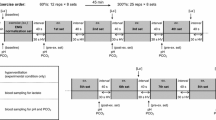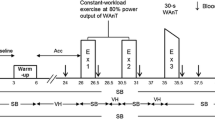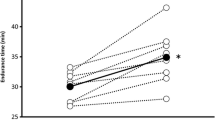Summary
These experiments examined the exercise-induced changes in pulmonary gas exchange in elite endurance athletes and tested the hypothesis that an inadequate hyperventilatory response might explain the large intersubject variability in arterial partial pressure of oxygen (P a02) during heavy exercise in this population. Twelve highly trained endurance cyclists [maximum oxygen consumption (VO2max) range = 65-77 ml·kg−1·min−1] performed a normoxic graded exercise test on a cycle ergometer toVO2max at sea level. During incremental exercise atVO2max 5 of the 12 subjects had ideal alveolar to arterial P02 gradients (P A-aO2) of above 5 kPa (range 5-5.7) and a decline from restingP aO2 (ΔP aO2) 2.4 kPa or above (range 2.4-2.7). In contrast, 4 subjects had a maximal exercise (P A-aO2) of 4.0-4.3 kPa with ΔP aO2 of 0.4-1.3 kPa while the remaining 3 subjects hadP A-aO2 of 4.3-5 kPa with ΔP aO2 between 1.7 and 2.0 kPa. The correlation between PAO2 andP aO2 atVO2max was 0.17. Further, the correlation between the ratio of ventilation to oxygen consumption VSP aO2 and arterial partial pressure of carbon dioxide VSP aO2 atVO2max was 0.17 and 0.34, respectively. These experiments demonstrate that heavy exercise results in significantly compromised pulmonary gas exchange in approximately 40% of the elite endurance athletes studied. These data do not support the hypothesis that the principal mechanism to explain this gas exchange failure is an inadequate hyperventilatory response.
Similar content being viewed by others
References
Astrand P, Rodahl K (1986) Textbook of work physiology. McGraw-Hill, New York
Barr P, Beckman M, Bjurstedt H, Brismar J, Hesser C (1964) Time courses of blood gas changes provoked by light and moderate exercise in man. Acta Physiol Scand 60:1–17
Brooks G, Fahey T (1984) Exercise physiology: human bioenergetics and its applications. Wiley, New York, p 271
Dempsey J, Hanson P, Henderson K (1984) Exercise-induced arterial hypoxemia in healthy persons at sea level. J Physiol (Lond) 355:161–175
Gledhill N, Froese A, Dempsey J (1977) Ventilation to perfusion distribution during exercise in health. In: Dempsey, Reed (eds) Muscular exercise and the lung. University of Wisconsin Press, Madison, pp 325–343
Gledhill N, Spriet L, Froese A, Wilkes D, Meyers E (1980) Acidbase status with induced erythrocemia and its influence on arterial oxygenation during heavy exercise. Med Sci Sports Exerc 12:122
Hansen J, Casaburi R (1987) Validity of ear oximetry in clinical exercise testing. Chest 91:333–337
Holmgren A, Linderholm H (1958) Oxygen and carbon dioxide tensions of arterial blood during heavy and exhaustive exercise. Acta Physiol Scand 44:203–215
Lawler J, Powers S, Thompson D (1988) Linear relationship betweenVO2max andVO2max decrement during exposure to acute hypoxia. J Appl Physiol 64:1486–1492
Murray J (1986) The normal lung. Saunders, Philadelphia, pp 170–171, 344-348
Powers S, Williams J (1987) Exercise-induced hypoxemia in highly trained athletes. Sports Med 4:46–537
Powers S, Dodd S, Woodyard J, Beadle R, Church G (1984) Alterations in hemoglobin saturation during incremental arm and leg exercise. Br J Sports Med 18:212–216
Powers S, Lawler J, Dempsey J, Dodd S, Landry G (1989) Effects of incomplete pulmonary gas exchange onVO2max. J Appl Physiol 66:2491–2495
Powers S, Dodd S, Criswell D, Lawler J, Martin D, Grinton S (1991) Evidence for an alveolar-arterialPO2 gradient threshold during incremental exercise. Int J Sports Med 12:313–318
Riley R, Lilienthal J, Proemmel D, Frankee R (1946) On the determination of the physiologically effective pressure of oxygen and carbon dioxide in alveolar air. Am J Physiol 147:191–198
Rowell L, Taylor H, Wang V, Carlson Y (1964) Saturation of arterial blood with oxygen during maximal exercise. J Appl Physiol 19:284–286
Saltin B (1990) Cardiovascular and pulmonary adaptation to physical activity. In: Bouchard C, Shephard R, Stephens T, Stephens J, Sutton J, McPherson B (eds) Exercise, fitness and health. Human Kinetics, Champaign, Ill., pp 187–204
Severinghaus J (1966) Blood gas calculator. J Appl Physiol 21:1108–1116
Wagner P, Gale G, Moon R, Torre-Burno J, Stolp B, Saltzman H (1986) Pulmonary gas exchange in humans exercising at sea level and simulated altitude. J Appl Physiol 61:260–270
Wasserman K, Van Kessel A, Burton G (1967) Interactions of physiological mechanisms during exercise. J Appl Physiol 22:71–85
Williams J, Powers S, Stuart M (1986) Hemoglobin desaturation in highly trained athletes during heavy exercise. Med Sci Sports Exerc 18:168–173
Author information
Authors and Affiliations
Rights and permissions
About this article
Cite this article
Powers, S.K., Martin, D., Cicale, M. et al. Exercise-induced hypoxemia in athletes: Role of inadequate hyperventilation. Europ. J. Appl. Physiol. 65, 37–42 (1992). https://doi.org/10.1007/BF01466272
Accepted:
Issue Date:
DOI: https://doi.org/10.1007/BF01466272




